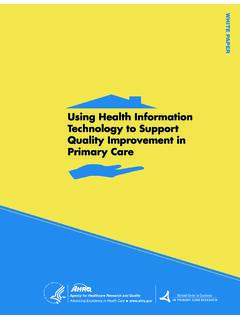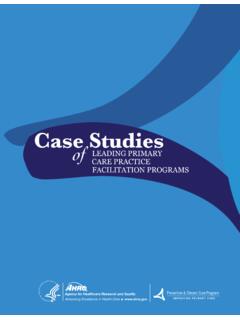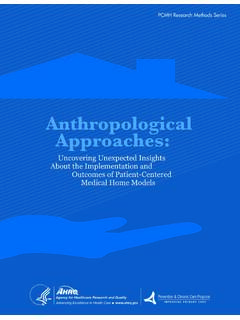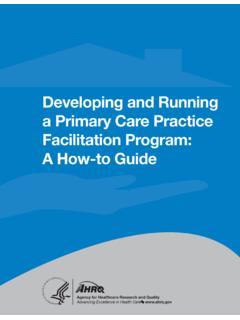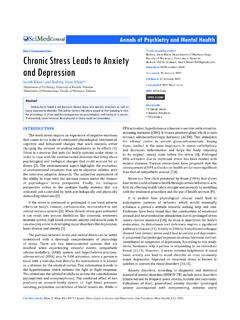Transcription of Mixed Methods: Integrating Quantitative and Qualitative ...
1 C Agency for Healthcare Research and QualityAdvancing Excellence in Health Care PCM Portfolio graphic element is intended to be closely aligned with AHRQ's overall brand, while also Chronic Care Model. Each stroke within the graphic represents a pillar of the model: the healthcare system, the community, and the doctor/patient relationship. These are distinct areas that also work together as part of an Prevention & Chronic Care ProgramIMPROVING PRIMARY CAREP revention & Care Management PortfolioIMPROVING PRIMARY CARE Mixed Methods: Integrating Quantitative and Qualitative Data Collection and Analysis While Studying Patient-Centered Medical Home Models PCMH Research Methods Series1 Mixed Methods.
2 Integrating Quantitative and Qualitative Data Collection and Analysis While Studying Patient-Centered Medical Home ModelsThis brief focuses on using Mixed methods to evaluate patient-centered medical home (PCMH) models. It is part of a series commissioned by the Agency for Healthcare Research and Quality (AHRQ) and developed by Mathematica Policy Research under contract, with input from other nationally recognized thought leaders in research methods and PCMH models. The series is designed to expand the toolbox of methods used to evaluate and refine PCMH models.
3 The PCMH is a primary care approach that aims to improve quality, cost, and patient and provider experience. PCMH models emphasize patient-centered, comprehensive, coordinated, accessible care, and a systematic focus on quality and Mixed Methods Studies The term Mixed methods refers to an emergent methodology of research that advances the systematic integration, or mixing, of Quantitative and Qualitative data within a single investigation or sustained program of inquiry. The basic premise of this methodology is that such integration permits a more complete and synergistic utilization of data than do separate Quantitative and Qualitative data collection and analysis.
4 The evaluation of PCMHs provide an ideal opportunity for Mixed methods studies to contribute to learning about best practices in how to implement a PCMH as well as PCMH effectiveness in achieving the triple aim outcomes of cost, quality, and patient experience of methods research originated in the social sciences and has recently expanded into the health and medical sciences including fields such as nursing, family medicine , social work, mental health, pharmacy , allied health, and others. In the last decade, its procedures have been developed and refined to suit a wide variety of research questions (Creswell and Plano Clark, 2011).
5 These procedures include advancing rigor, offering alternative Mixed methods designs, specifying a shorthand notation system for describing the designs to increase communication across fields, visualizing procedures through diagrams, noting research questions that can particularly benefit from integration, and developing rationales for conducting various forms of Mixed methods core characteristics of a well-designed Mixed methods study in PCMH research include the following:1. Collecting and analyzing both Quantitative (closed-ended) and Qualitative (open-ended)
6 Using rigorous procedures in collecting and analyzing data appropriate to each method s tradition, such as ensuring the appropriate sample size for Quantitative and Qualitative Integrating the data during data collection, analysis, or Using procedures that implement Qualitative and Quantitative components either concurrently or sequentially, with the same sample or with different Framing the procedures within philosophical/theoretical models of research, such as within a social constructionist model that seeks to understand multiple perspectives on a single issue for example, what patients, caregivers, clinicians, and practice staff would characterize as high-quality treatment in a brief focuses on the potential uses of this methodology for PCMH research as well as on specific Mixed methods designs in primary care research (Creswell, Fetters, and Ivankova, 2004)
7 That offer feasible, information-rich data that can enhance traditional Quantitative research Uses of Mixed Methods Research DesignsMixed methods can be an ideal technique to assess complex interventions such as PCMHs (Homer, Klatka, Romm, et al., 2008; Nutting, Miller, Crabtree, et al., 2009). PCMH evaluators can choose from five primary Mixed methods designs depending on the research questions they want to answer and resources available for the evaluation. Validate findings using Quantitative and Qualitative data sources. Evaluators can use a convergent design to compare findings from Qualitative and Quantitative data sources.
8 It involves collecting both types of data at roughly the same time; assessing information using parallel constructs for both types of data; separately analyzing both types of data; and comparing results through procedures such as a side-by-side comparison in a discussion, transforming the Qualitative data set into Quantitative scores, or jointly displaying both forms of data. For example, the investigator can gather Qualitative data to assess the personal experiences of patients while also gathering data from survey instruments measuring the quality of care.
9 The two types of data can provide validation for each other and also create a solid foundation for drawing conclusions about the Qualitative data to explore Quantitative findings. This explanatory sequential design typically involves two phases: (1) an initial Quantitative instrument phase, followed by (2) a Qualitative data collection phase, in which the Qualitative phase builds directly on the results from the Quantitative phase. In this way, the Quantitative results are explained in more detail through the Qualitative data. For example, findings from instrument data about costs can be explored further with Qualitative focus groups to better understand how the personal experiences of individuals match up to the instrument results.
10 This kind of study illustrates the use of Mixed methods to explain qualitatively how the Quantitative mechanisms might survey instruments. Yet another Mixed methods study design could support the development of appropriate Quantitative instruments that provide accurate measures within a PCMH context. This exploratory sequential design involves first collecting Qualitative exploratory data, analyzing the information, and using the findings to develop a psychometric instrument well adapted to the sample under study. This instrument is then, in turn, administered to a sample of a population.
